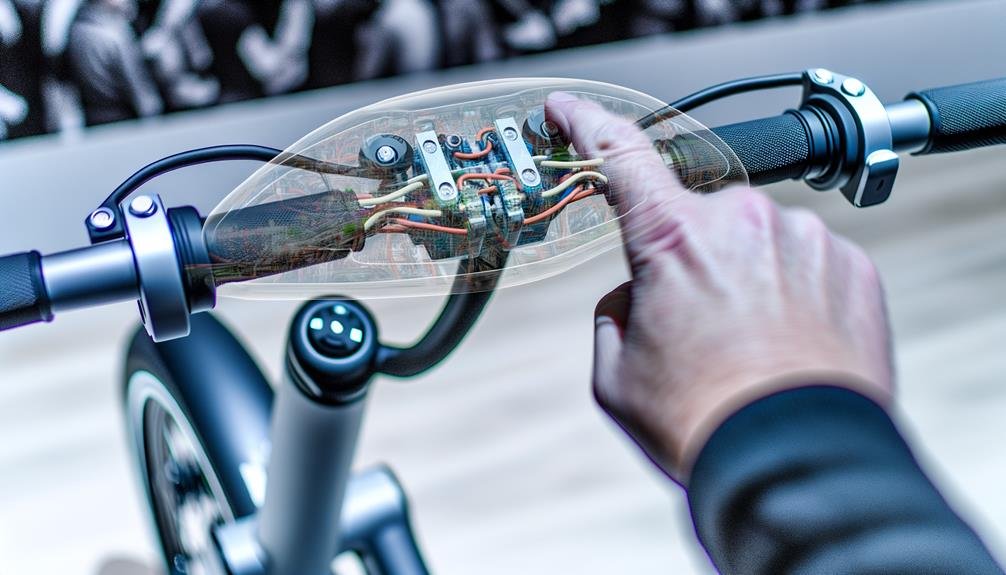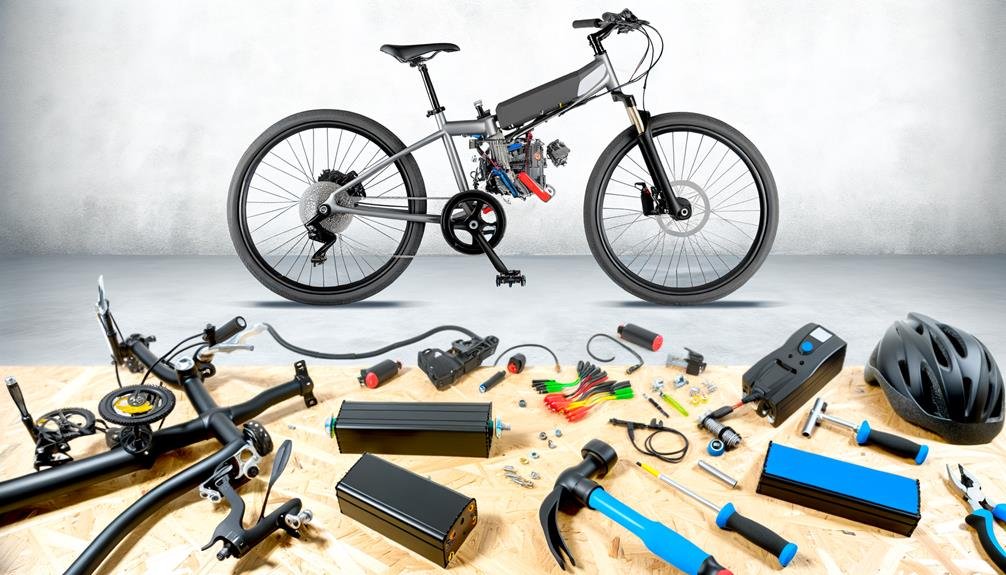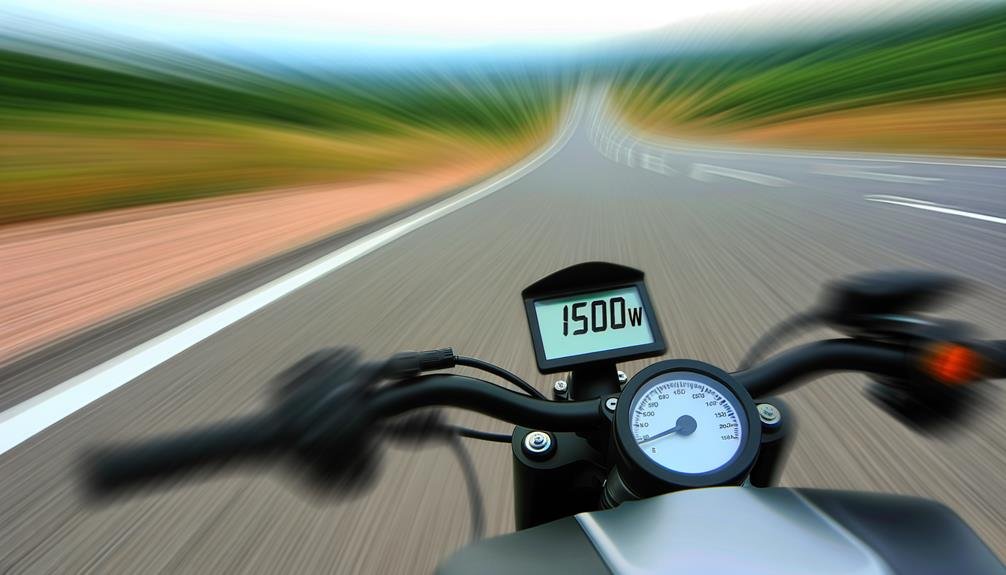Charles Miller is a veteran bike enthusiast with over 12 years of experience dealing with bikes as a mechanic. Despite immense love and expertise for...
Have you ever wondered how an electric bike works? As a bicycle enthusiast and professional tech writer, I've been captivated by the simple yet ingenious mechanics behind these modern machines.
At its core, an e-bike is powered by a battery-operated motor, but there's much more to it than that. The interplay of technology and human effort in these devices is a fascinating blend of modern innovation and age-old mechanical principles.
So, let's take a journey into the world of electric bikes – I promise, it's a ride worth taking.
Key Takeaways
- Electric bikes consist of a motor, a battery, and a handlebar-mounted display.
- The motor provides power assistance when you pedal, making uphill climbs and long-distance rides easier.
- The pedal assist system enhances your ride by balancing human effort and electric motor support.
- The range of an electric bike depends on battery capacity, motor efficiency, terrain, weight, and pedaling input.
Understanding Electric Bikes
Let's break down how electric bikes, or e-bikes, work: they're made up of a motor, a battery, and a system to deliver power, usually via a handlebar-mounted display. This trio creates a harmonious synergy that propels you forward, making your journey easier and more enjoyable.
First, the motor, typically a brushless rear hub motor located on the back wheel, aids in moving the bike. It's like having a helpful friend pushing you along.
Next, we've got the battery. Commonly, it's a rechargeable lithium-ion type that provides varying wattages. This power source is like the energy drink that keeps you going, impacting how far you can travel on your e-bike.
Now, the handlebar-mounted display; it's your control panel. From here, you decide how much electricity the hub motor receives either through pedal assist or a throttle. It's like having a personal conductor for your electric symphony.
Understanding electric bikes and how they work is like embracing a new community – a community that values efficiency, innovation, and the joy of movement. As technology advances, we can look forward to seeing how e-bikes work evolve, further enhancing our belonging in this electrifying world.
Key Components of E-bikes
Diving into the key components of e-bikes, we find pedals, gears, a motor, a battery, and a control unit or display as the main elements. This isn't your grandfather's bike, but a sleek, modern machine that combines traditional cycling with electric power assistance.
The electric motor is the heart of an e-bike that provides power assistance. It's what makes hills feel flatter and long distances seem shorter.
- Pedals and Gears: Just like a regular bike, these help you move and control your speed. But on an e-bike, they also interact with the motor to provide a seamless biking experience.
- Motor: This is where the magic happens. The electric motor kicks in when you need it, helping you conquer hills and cover long distances with ease.
- Battery: The e-bike's battery powers the motor and other components. It's what keeps the wheels turning, the display glowing, and the control unit functioning.
- Control Unit/Display: This is your command center. It lets you choose how much help you get from the motor and displays useful information like speed, distance, and battery life.
The Role of The Motor

Understanding the motor's role in an e-bike is crucial, as it's a 250-watt brushless rear hub motor typically found on the back wheel, which provides power assistance when you pedal. This ebike motor is a game-changer, adding power and, essentially, giving the back wheel a good old push. It's like having a helpful friend constantly giving you a boost, making uphill climbs and long-distance rides a breeze.
This motor uses sensor data to determine how much help you need. It's responsive, adjusting the motor power based on your pedal movement. You're not alone in this, your e-bike's got your back. It knows when to conserve battery power when you're cruising along comfortably, and when to kick in with that extra push when you need it.
The role of the motor isn't just about power, it's about companionship on your journey. Through the display mounted on the handlebar, you have control over the level of assist. It's like a dialogue between you and your ride. The motor's role is to provide support when you need it, making your ride smoother, easier, and a whole lot more enjoyable.
Battery: The Power Source
While the motor plays a critical role in propelling the e-bike, it's the rechargeable lithium-ion battery that fuels this power, serving as the unsung hero in our electric biking journey. It's this battery that provides the wattage needed to power the motor.
Now, let's dive into the specifics of what makes this battery so vital:
- Location: Usually, you'll find the battery on the down tube or above the rear tire on a rack in Schwinn e-bikes. It's strategically placed for balance and efficiency.
- Battery Capacity: The battery capacity determines how far you can travel. While it doesn't affect speed, it does dictate the distance you can cover. For instance, Schwinn's smaller batteries can provide up to 20 miles per charge, while larger batteries can deliver up to 80 miles.
- Power: The power that propels your e-bike comes from the battery, making it an essential component.
- Recharge: Lithium-ion batteries need to be charged after use. They're light, affordable, and easy to recharge, unlike the heavy, bulky lead-acid batteries.
Pedal Assist Functionality

Let's now turn our attention to the pedal assist functionality, a key feature of electric bikes.
We'll first get to grips with how the pedal assist system works, before looking at the benefits it offers to riders.
We'll also compare it with the throttle mode, to give you a clearer understanding of its advantages.
Understanding Pedal Assist System
If you've ever wondered how pedal assist systems enhance your ride on an e-bike, it's all about a smart balance of human effort and electric motor support. Understanding the pedal assist system is crucial for mastering your e-bike.
Here's how it works:
- The pedal assist function kicks in when you start pedaling, activating the mid-drive motor to support your efforts.
- You can choose different levels of assistance based on your need, letting you customize your ride.
- The motor doesn't stop you from changing gears like on a regular bike. It keeps helping as long as you keep pedaling.
- The battery powers the electric parts of the e-bike, enabling support modes and tracking ride data.
Benefits of Pedal Assist
Diving into the benefits of pedal assist functionality, it's clear to see how this innovative feature enhances your e-bike experience by harmoniously blending technology and physical effort.
The pedal assist system provides the perfect balance, giving you just the right level of assistance when needed, making your ride smoother and less strenuous. It's like having a friend who's always there to give you a boost when the going gets tough.
With the variable level of assistance, you can customize your ride on your e-bike to suit your personal preference.
The benefits of pedal assist don't end there, it also promotes physical activity. You're still using pedal power, engaging in exercise while enjoying a less strenuous experience.
The pedal assist system is truly the heart of what makes riding an e-bike so enjoyable.
Pedal Assist Vs. Throttle
Comparing pedal assist and throttle functionality, we find key differences in how these two systems engage the motor on an e-bike.
- Pedal assist vs. throttle: Pedal assist offers power only when you pedal, unlike throttle where power is delivered at a simple twist or push of a button.
- Bike motors: Pedal assist uses sensors to determine the power output from the motor, while throttle control gives constant power.
- Power output: Pedal assist provides power based on your pedaling force and speed, while throttle offers a steady power output.
- Maximum speed: With pedal assist, you can achieve higher speeds as it combines your pedaling power and the motor's output. Throttle, on the other hand, depends solely on the motor's power.
These differences can help you choose the best e-bike to belong in the ebike community.
Operating an Electric Bike

Now that we've touched on pedal assist functionality, let's move on to understanding how to operate an electric bike.
We'll discuss the various components of the E-bike, how to ride it, and even some basic maintenance tips.
Electric Bike Components
Let's take a closer look at how to operate an electric bike, starting with its key components: pedals, gears, a motor, a battery, and a control unit/display.
Here's a simple breakdown of how electric bike works:
- Pedals and gears function like a traditional bike, located around the bottom bracket area.
- The type of motor kicks in when you start pedaling, providing the extra boost.
- The battery, usually attached to the frame, powers the motor and display.
- The control unit allows you to adjust the level of motor assistance.
Understanding these electric bike components is integral to enjoying your ride. As part of our biking community, it's great to have you on board, exploring the ins and outs of e-bikes.
Riding and Maintenance
Having unraveled the basic components of an electric bike, we're all set to explore how to ride and maintain one.
Turning on the bike involves simply pressing the power button on the control unit and selecting your preferred support mode.
This is where the real magic happens, as the pedal-assist feature propels the bike according to the force you apply on the pedals. Adjusting the mode during the ride enhances the riding experience, tailoring the level of motor assistance to your needs.
The battery's role is also crucial, powering all electric components. Understanding how an electric bike works helps in its maintenance, ensuring a smooth and efficient ride every time.
Welcome to the e-bike community, where we take riding and maintenance seriously.
E-bike Weight Considerations
Although electric bikes are heftier than non-assisted bikes due to the motor and battery, they still provide a solid workout and unique riding experience. Understanding e-bike weight considerations is essential to maximize this experience.
The weight of an e-bike is primarily influenced by two elements: the motor and the battery. Depending on the model, the weight of these components can vary. Some of the best electric road bikes have lighter systems weighing less than 4kg, with the average e-bike weighing around 6 to 8kg.
To add depth, here's a list of four key factors to consider:
- The weight of the motor, usually a hub motor, contributes significantly to the overall weight.
- The battery's weight is also a factor. A higher capacity might mean more weight.
- Additional mounting points and frame reinforcements can add extra weight.
- Despite the weight, remember that pedaling is still required for propulsion, offering a solid workout.
Range and Efficiency

Diving into the realm of range and efficiency, it becomes clear that an electric bike's performance hinges greatly on its battery capacity and motor efficiency. As an e-bike owner, you're part of a community that values sustainability and convenience. Knowing the ins and outs of your bike, particularly its range and efficiency, is a key part of making the most of your ride.
The range of an electric bike is how many miles it can travel per charge. Smaller batteries might provide up to 20 miles per charge, while larger ones can deliver up to 80 miles. This makes them incredibly efficient for both short commutes and longer rides. However, remember that factors like terrain, weight, and your own pedaling input can affect this.
Motor efficiency is another crucial aspect. Mid-drive motors, for instance, are known for their efficiency as they allow you to adjust the level of assistance based on your energy output and the type of terrain you're tackling.
Keeping your bike in good shape, through proper battery and motor maintenance, can also significantly improve its range and efficiency. This ensures you're always ready for your next adventure.
Converting Regular Bikes to E-bikes
While understanding your e-bike's range and efficiency is essential, you might also be intrigued by the possibility of converting your regular bike into an e-bike. If you're a DIY enthusiast, this option might be just what you're looking for.
You might ask, 'Why would I want to do that?' Well, the e-bike provides many benefits, including extended range and easier riding, especially uphill.
Here's a simple guide to converting regular bikes to e-bikes:
- Add a Motor: You'll need to install a motor. Mid-drive motors are often a good choice because they balance the bike's weight nicely. The motor is usually attached to the rear wheel for propulsion.
- Integrate a Battery: Next, you'll need to add a rechargeable lithium-ion battery which powers the motor. These are often mounted on the top tube of the bike for convenience.
- Install a Control System: The control system typically includes a display mounted on the handlebars. This allows you to adjust the power assistance levels.
- Test and Tune: Once all parts are installed, you'll need to test your new e-bike and make any necessary adjustments.
Frequently Asked Questions
How Does a Electric Bike Work?
When I pedal my electric bike, the motor kicks in, boosting my efforts. It's powered by a rechargeable battery. I can adjust the power level on the handlebar display. It's like cycling with a constant tailwind!
Do Electric Bikes Work Without Pedaling?
Sure, an electric bike can work without me pedaling. It's like a lazy Sunday afternoon, but on wheels. I just use the throttle and off I go, no sweat. It's effortless and oh so convenient.
Do Electric Bikes Charge as You Pedal?
Yes, some electric bikes do charge as you pedal, through a process called regenerative braking. However, it's a feature not present in all models, and the energy generated this way isn't a significant charge source.
Is It Harder to Pedal an Electric Bike?
No, it's not harder to pedal an electric bike. It's like having an invisible hand giving you a boost. The motor assists you, making pedaling less strenuous. It's a great helper for those uphill battles.
Conclusion
So, as I wrap up, you might be wondering, what's the real magic of e-bikes?
It's not just the battery or the motor, but the power of possibility. Imagine tackling that steep hill with a smile, or extending your journey beyond the usual.
An e-bike isn't just a bike with a motor, it's a ticket to a new world of biking. And who knows? With a bit of tinkering, your old regular bike could join the revolution.
What's stopping you?

Charles Miller is a veteran bike enthusiast with over 12 years of experience dealing with bikes as a mechanic. Despite immense love and expertise for his Tacoma, he rides his Trek Ebike more. Anytime you meet him, you’ll either hear him talking about Bikes, or writing about all things bikes and cars on this blog.
More Posts


